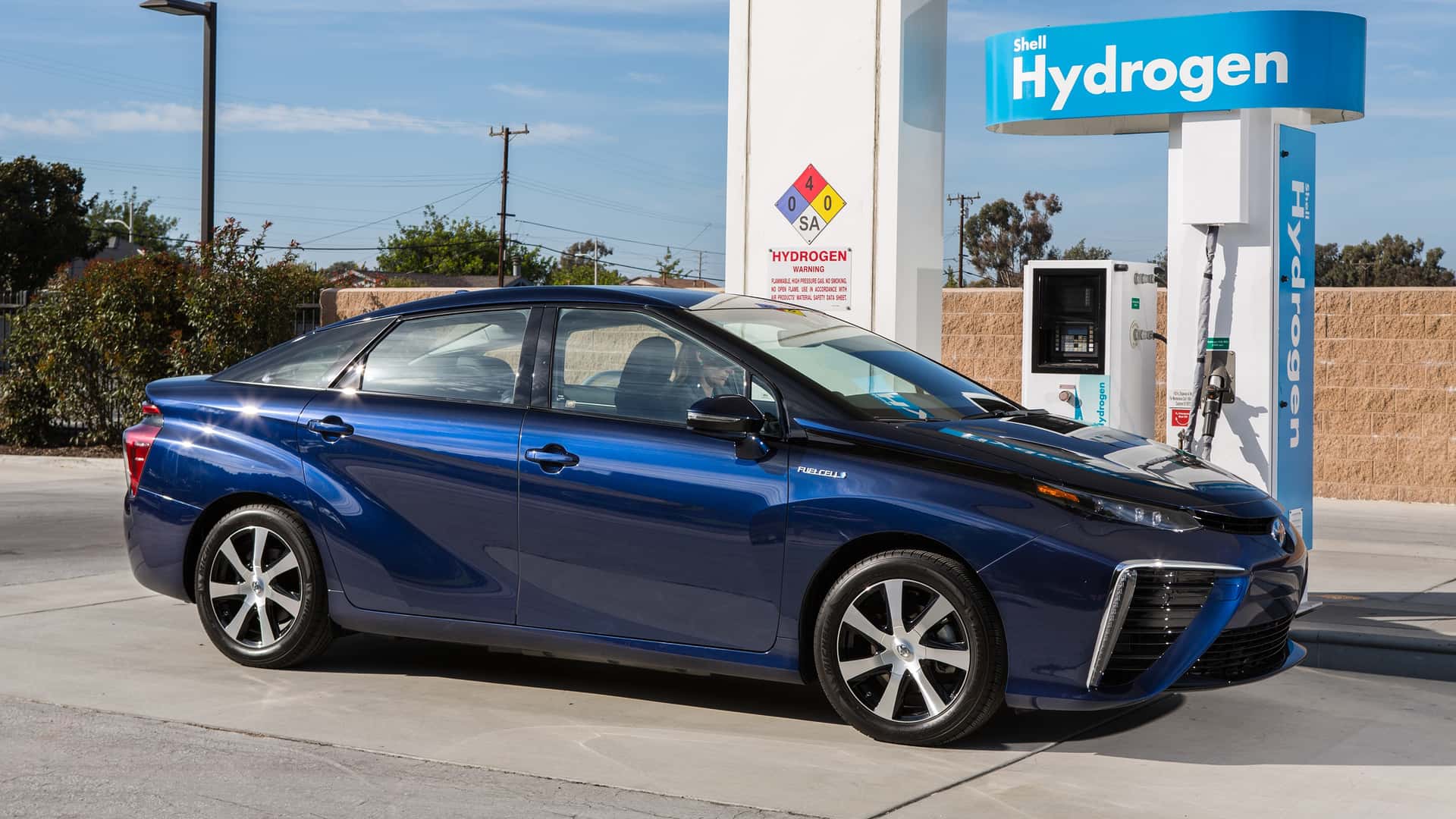Shell Is Immediately Closing All Of Its California Hydrogen Stations | The oil giant is one of the big players in hydrogen globally, but even it can’t make its operations work here.::The oil giant is one of the big players in hydrogen globally, but even it can’t make its operations work here. All seven of its California stations will close immediately.
Looking forward to the upcoming Toyota announcement that they believe in the future of hydrogen more than ever
Toyota, and Japan as a whole, are in a tricky situation with their electric grid. It’s been developed separately by nine different companies in each region; the southern regions use 60 Hz supply cycles, where-as the northern regions (including Tokyo Electric) use 50 Hz. Add to this the populations reluctance for nuclear power after Fukushima, and you get a very fragile supply grid with limited capacity. Toyota is gunning hard for Hydrogen because Japan itself can’t support EVs and for some reason it doesn’t want to/can’t manufacture both.
Okay, but if they don’t have the electricity for EVs they definitely don’t have enough electricity to waste 2/3 of it turning it into hydrogen and back.
I mean yeah, but on the other hand with hydrogen you have much more control over when and where you use the electricity as you can choose to manufacture most of it during off-peak periods and when renewables create excess energy. Then you can transport it by pipes or by trucks/ships without overwhelming the electric grid.
You can do off-peak charging with EVs too, that’s not a magical hydrogen thing. My hot water system is on its own circuit which can be turned off by the power company whenever they need to cut demand, providers have been doing that sort of thing for decades.
I’m not sure I buy that. Yes, their electrical grid is a mismatched nightmare, that they should have taken the hit on decades ago. However I see that small chargers for things like phones can adjust to pretty much any electrical grid: why shouldn’t we expect the charger in the car to be equally flexible? Either way, it’s converting to DC
Edit: the article didn’t talk about the differences, except frequency: if the only difference is 50Hz vs 60Hz, most analog electrical stuff probably also works on both. The real problem is they don’t have interconnects nor do they have a regulatory structure allowing separate generating oroviders
My main point was about capacity, and how the separate grid(s?) hinder attempts to add the capacity needed for EVs. I wasn’t really clear on that though. mb
They also recently announced an anhydrous ammonia engine.
They really really don’t want to do an electric car. Anhydrous ammonia is insanely toxic. You ever spill a like a few drops of gas at the pump and get it on your pants or shoe? Annoying but not a big deal. Do that with anhydrous ammonia and you’ll be in the hospital.
It can also be used to make methamphetamine.
So what I’m hearing is, if I build my own electrolysis station driven by a solar panel array, there’s quickly going to be a glut of extremely cheap hydrogen cars coming out of So.Cal…
I mean, how many people bought them even there? Isnt there like, one model that anyone has even tried to sell to the public, just from toyota stubbornly insisting that EVs wont work despite all the working EVs that already exist?
Enough that there will still be some available. If hydrogen becomes unavailable then the car’s values drop to almost zero regardless of how many there are.
edit: California Energy Comission reports that there were a hair under 12,000 hydrogen fuel-cell vehicles operating in California in 2023
I live in the Bay Area and I’ve seen a surprising number of them. But then again I think their R&D office is in a nearby city so maybe it’s just a bunch of employees driving them.
I think that Toyota recently announced they sold a total of 14,000 (in the US, I’m assuming). They also announced that they were planning on continuing production on the same article, but I don’t know what this will do to their plans.
First of all, there are three (popular) hydrogen cars available, and only one of them is from Toyota. And more are scheduled to launch very soon.
Everyone who’s tested those three cars loves them. The Toyota Mirai is supposedly very similar to, and in fact nicer than, the Lexus LS 500 and it’s also tens of thousands of dollars cheaper than that car. When (and I believe it is a “when”) hydrogen is easier to access, it’s going to take off.
The only real drawback Hydrogen ever had was cost. But that’s not an issue anymore, prices have come down a lot. And the “range anxiety” issue is helped tremendously by just having a really really long range. You’re only going to fill up twice a month or so.
Hydrogen’s fundamental problem is that it isn’t competing with fossil fuels any more, it’s competing with battery EVs. And the inefficiency means even if all the filling station hardware was free, driving on hydrogen can never be less than three times the cost of driving on electricity.
So what I’m hearing is, if I build my own electrolysis station driven by a solar panel array, there’s quickly going to be a glut of extremely cheap hydrogen cars coming out of So.Cal…
That’s the fun thing - after you make the hydrogen you have to compress it to 10,000 PSI and cool it to -40 to actually get it into the car. And make sure the pumps, pipes and cooling gear are all made of materials that won’t be destroyed by exposure to high pressure hydrogen.
It’d probably be a lot cheaper and easier to gut the car and replace the fuel cell and tanks with batteries and a charger.
Wonder if Toyota will take back all those Mirais that will be stranded on the side of the road otherwise?
EVs, Hydrogen Cells, Vegetable Oil, all these alternatives are here to save one thing; The Car Industry. Sounds like the problem might be mode of transport rather than fuel.
Oh, come on, I live in Copenhagen and cycle daily, but even there, cars are not going anywhere. Smelly-smokey cars, yes, but not cars in general.
Cars aren’t being eliminated completely, but we can significantly reduce their usage if we look to your home city as an example. In Copenhagen, only 44% of commutes are made by car. In the Bay Area, probably the least car-centric area of California, 85% of commutes are by car (I removed the 33% WFH, so 58/67=85%).
What is the argument here? Cars are here to stay forever and ever? Most daily commuters could get used to a train. It is possible for most people to live without a car, your city was just designed in a way that requires you to.
That’s the point, we can’t exactly just resign a city from the ground up to work with public transit especially when it’s not being pushed for by the majority
Yes but what is the alternative? Can civilians all have their own car when 10 million live in a city? What about 30 million? 100? It stops making sense the more people you have. And on top of that suppliers and transportation services use the same road, too. It is already like flying through the death star out here with half the road being eaten by transportation companies.
Well with the way the birthrates are going, I think population is going to stabilize.
Then you’re not looking.
https://www.macrotrends.net/countries/WLD/world/birth-rate
It is still going up just much more slowly. To say we shouldn’t worry about efficiency cause there will never be that many people disregards the benefits of unloading all of these personal costs to individuals. Vehicles are expensive on top of everything.
Most daily commuters could get used to a train
It’s definitely not “most”. You have to live and work near a train station for that to be viable option. It’s not about “getting used to” trains, it’s just for most commutes a train simply takes too long - because they don’t go directly to your destination.
In Denmark, which has one of the best transit networks in the world, only 13% of commuting is by public transport. 20% is by bicycle. Cars are 60%.
So what’s more practical, slowly replacing all ICE cars or completely redesigning entire cities, bulldozing large metro blocks to reconfigure and rebuild?
A little column A, a little column B. Mostly, we can have gentle changes to our cities, like removing Single-Family Home and other exclusionary zoning, removing mandatory parking minimums, as well other initiatives to encourage higher density, mixed-use buildings, and active transportation usage.
As I just commented. How many individuals can drive cars before congestion makes it impossible? 10 million people? 20? 30? The I-10 and 101 stack interchange is already a fucken mess that can’t be expanded. How do you handle exponentially more drivers on the road each year?
Edit: you don’t even have to answer cause we already know from California, you don’t. The rich people just pay pilots to fly them and the plebs get stuck in 2+ hour traffic to go 20 miles.
How many individuals can drive cars before congestion makes it impossible
It’s impossible to answer that - there are just too many other variables, such as how far are people travelling each day on average, how many of them are going to the same destination, how many roads are there (not how many lanes, how many roads), etc etc.
A lot of the problem can be mitigated with zoning rules to encourage people not to travel to the inner city. Whatever reason they might have to go to the CBD should also be available elsewhere in the city if at all possible.
The fact is trains also have traffic issues and that tends to get a lot worse as you increase the number of train lines in your city. The efficiency of train travel is in part because not many people use that mode of transport. Cities that have 10% of travel by train now probably can’t expand that to 80%.
Diversity is the only option. Give people access to every mode of transit, and let them pick the best one. I’m not from California so I don’t know the local issues, but looking at a map I-10 has six train lines that run basically parallel to it. Trains are clearly available so why are people choosing to drive? I’m sure they have a reason. Rather than trying to add more train lines, how about figure out why people are driving that route and tackle it from that perspective? What are they heading into LA for? Can it be done somewhere else?
As much as I’d like to use public transport, even with LA traffic on a Thursday (for those who don’t know, Thursdays are always the worst in LA), even when the 405 is a parking lot, taking the metro / bus is still at least 2x slower than driving. Yes I tried, it’s that ridiculous. There are a lot of ongoing projects to build and extend metro lines, new bike lanes, etc. but progress is very slow. As others have said, the whole metropolitan area was designed with cars, and only cars in mind.
I do keep hoping one of these will succeed though: we have many different things that move and need multiple solutions to kick our fossil fuel habit.
Walkable cities with train systems are ideal but will take decades to build out, plus at least in the US, we have predictions of people moving away from cities
Battery seems to have won best technology for personal transportation, whether scooters, bikes cars. However will take a couple decades, or more in the face of conservative resistance to change
But what about all those trucks, aircraft, construction and farming equipment, shipping, military vehicles? That’s a lot of fossil fuel usage and a lot of experiments but no solution in sight
clearly never lived in a rural setting
I’m clearly talking about cities. Where most people live.
Where most people think their food supply line is invincible.
Rural communites still use their space inefficiently. You dont need a mile between houses. Natural resource generation takes no personal freedoms into account, nor does it take human comfort. We have one pie to share until the sun explodes. Best figure out how to share it.
You ever think that maybe farm/grazing fields are the reason rural homes are spaced so far apart?
Regardless, cars definitely contribute to climate change, but they’re a drop in the bucket compared to industrial pollution. It makes me wonder why there isn’t the same level of hyper fixation on replacing those technologies with carbon neutral solutions as replacing personal vehicles. Let’s just keep those enormous cargo ships burning bunker fuel 24/7. Hell, even large scale meat farms are quite dangerous, as methane is even worse than CO2. You’d think there’d be more of a focus on regulating and slowing down large scale meat production.
If you can’t get people to drop cars, you aren’t going to get them to drop meat for meat alternatives. Its just the piece of our culture that has been deemed easier to change since there are alrsady successful examples of it across the world. Meanwhile, what country has no meat industry and provides a first world standard of living? It may exist, I dont think so though.
Yes, I do think they are further apart due to farms and grazing. My family has a farm in Alabama that has been slowly shrinking because of costs. Does every house out there have its own farm? No! Some of the land plots for newer builds were sold off from my family’s farm, meaning it now envelopes the newer property. Are they still spaced far enough apart that you can’t even tell someone else lives on the property? Of course they are!
Either way, we’ll have these conversations until you and I are rubbing elbows on the $5 per half mile ride share to the corpse starch manufactorum.
Ah yes, so all the houses people rarely visit are located close together and the farms they have to visit multiple times a day are even further away?
Deranged thinking by someone who has never considered that their food is grown in a field rather than some factory
If you design it in an asinine way, sure. All of these houses do not have personal farms. Most of them are either carved from the farm property, or already live off of it. Like my family’s farm in Alabama. They cut pieces of the land directly off of the road and sold it to the workers so they can live near the farm. They rode mountain bikes to work and used their cars to go into town or groceries. Everyone acting like there is no alternative in this thread, or we already do things the best way, is in denial.
“You don’t need a mile between houses.”
Never lived next door to a pig farm, did you
Hydrogen will have an important role to play in the future of green energy simply because it’s a portable high density fuel, that doesn’t require a battery to work.
The trade-off is that hydrogen takes more energy to create, then you get back. That doesn’t make a lot of sense when you’re using fossil fuels, but it would in a future with significant amounts of excess green energy e.g. wind, solar, fusion, etc.
HydrogenNatural Gasftfy.










